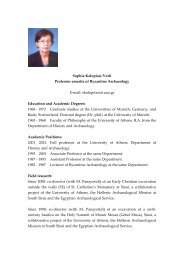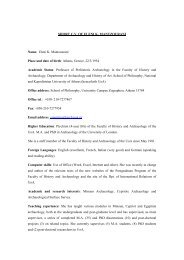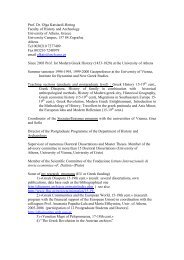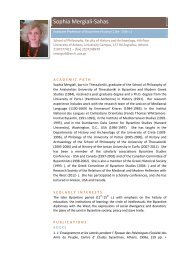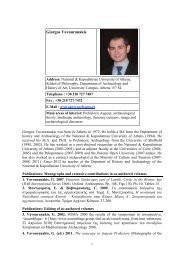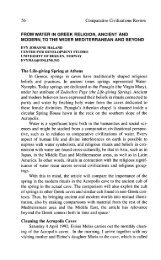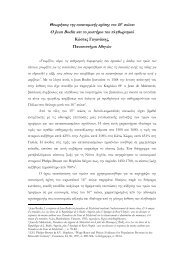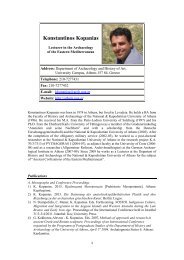The Dormition of the Virgin Mary on the Island of Tinos: A ...
The Dormition of the Virgin Mary on the Island of Tinos: A ...
The Dormition of the Virgin Mary on the Island of Tinos: A ...
You also want an ePaper? Increase the reach of your titles
YUMPU automatically turns print PDFs into web optimized ePapers that Google loves.
106 JOURNAL OF RELIGIOUS HISTORY<br />
and is built from <str<strong>on</strong>g>the</str<strong>on</strong>g> past, it transcends <str<strong>on</strong>g>the</str<strong>on</strong>g> past but does not reject it. <str<strong>on</strong>g>The</str<strong>on</strong>g><br />
Greeks are nei<str<strong>on</strong>g>the</str<strong>on</strong>g>r Hellenes nor Byzantines. <str<strong>on</strong>g>The</str<strong>on</strong>g>y are both.<br />
While political discourse makes use <str<strong>on</strong>g>of</str<strong>on</strong>g> religi<strong>on</strong> and religious symbolism and<br />
finds an opportunity for its expressi<strong>on</strong> in religious occasi<strong>on</strong>s such as those<br />
celebrated <strong>on</strong> 15 August, religious discourse also makes use <str<strong>on</strong>g>of</str<strong>on</strong>g> politics and<br />
political symbolism; <str<strong>on</strong>g>the</str<strong>on</strong>g>y are both complementary and interdependent. 31 This<br />
intermingling is particularly manifested in <str<strong>on</strong>g>the</str<strong>on</strong>g> aforementi<strong>on</strong>ed posters<br />
announcing <str<strong>on</strong>g>the</str<strong>on</strong>g> festival <strong>on</strong> <strong>Tinos</strong>, which reflect Byzantine manifestati<strong>on</strong>s, as<br />
well as paintings and newspapers from <str<strong>on</strong>g>the</str<strong>on</strong>g> war period. One <str<strong>on</strong>g>of</str<strong>on</strong>g> <str<strong>on</strong>g>the</str<strong>on</strong>g>se depicts a<br />
battleground filled with soldiers during <str<strong>on</strong>g>the</str<strong>on</strong>g> Greek-Italian war in 1940–1941.<br />
<str<strong>on</strong>g>The</str<strong>on</strong>g> Panagia and <str<strong>on</strong>g>the</str<strong>on</strong>g> child are hovering in <str<strong>on</strong>g>the</str<strong>on</strong>g> clouds above, accompanied by<br />
angels, <strong>on</strong>e <str<strong>on</strong>g>of</str<strong>on</strong>g> which carries a Greek flag. 32 According to some, <str<strong>on</strong>g>the</str<strong>on</strong>g> church also<br />
dedicated <str<strong>on</strong>g>the</str<strong>on</strong>g> whole collecti<strong>on</strong> <str<strong>on</strong>g>of</str<strong>on</strong>g> votive <str<strong>on</strong>g>of</str<strong>on</strong>g>ferings to assist <str<strong>on</strong>g>the</str<strong>on</strong>g> Allies during <str<strong>on</strong>g>the</str<strong>on</strong>g><br />
war, thus paralleling <str<strong>on</strong>g>the</str<strong>on</strong>g> Panagia’s participati<strong>on</strong> as illustrated in several pictures<br />
from <str<strong>on</strong>g>the</str<strong>on</strong>g> period. 33 Despite this maternal participati<strong>on</strong>, all <str<strong>on</strong>g>the</str<strong>on</strong>g> <str<strong>on</strong>g>of</str<strong>on</strong>g>ficial<br />
rituals performed by representatives <str<strong>on</strong>g>of</str<strong>on</strong>g> <str<strong>on</strong>g>the</str<strong>on</strong>g> nati<strong>on</strong> state and <str<strong>on</strong>g>the</str<strong>on</strong>g> church may be<br />
classified as bel<strong>on</strong>ging to a male world, representing male values, identity, and<br />
status. So what about <str<strong>on</strong>g>the</str<strong>on</strong>g> female?<br />
Female World, Values, Identity, and Status<br />
For Greeks, <str<strong>on</strong>g>the</str<strong>on</strong>g> events <str<strong>on</strong>g>of</str<strong>on</strong>g> 15 August are an expressi<strong>on</strong> <str<strong>on</strong>g>of</str<strong>on</strong>g> faith, and particularly<br />
<str<strong>on</strong>g>of</str<strong>on</strong>g> women’s faith and <str<strong>on</strong>g>the</str<strong>on</strong>g>ir identificati<strong>on</strong> with <str<strong>on</strong>g>the</str<strong>on</strong>g> Panagia. Generally, <str<strong>on</strong>g>the</str<strong>on</strong>g> Greek<br />
woman’s identity and status bel<strong>on</strong>g to female values, and in this c<strong>on</strong>necti<strong>on</strong> <str<strong>on</strong>g>the</str<strong>on</strong>g><br />
Panagia has a key role. Never<str<strong>on</strong>g>the</str<strong>on</strong>g>less, during <str<strong>on</strong>g>the</str<strong>on</strong>g> ritual chaos, which particularly<br />
is apparent in <str<strong>on</strong>g>the</str<strong>on</strong>g> processi<strong>on</strong>, we see a female world c<strong>on</strong>tra — and <str<strong>on</strong>g>of</str<strong>on</strong>g>ten in<br />
c<strong>on</strong>flict with — a male <str<strong>on</strong>g>of</str<strong>on</strong>g>ficial world represented by <str<strong>on</strong>g>the</str<strong>on</strong>g> Church and <str<strong>on</strong>g>the</str<strong>on</strong>g> police.<br />
<str<strong>on</strong>g>The</str<strong>on</strong>g> festival is dedicated to <str<strong>on</strong>g>the</str<strong>on</strong>g> most important mo<str<strong>on</strong>g>the</str<strong>on</strong>g>r, <str<strong>on</strong>g>the</str<strong>on</strong>g> Panagia. Fur<str<strong>on</strong>g>the</str<strong>on</strong>g>r,<br />
in family life, women are <str<strong>on</strong>g>the</str<strong>on</strong>g> central performers <str<strong>on</strong>g>of</str<strong>on</strong>g> <str<strong>on</strong>g>the</str<strong>on</strong>g> ritual acti<strong>on</strong>s performed<br />
to secure <str<strong>on</strong>g>the</str<strong>on</strong>g> family’s life and health. Accordingly, <strong>on</strong> <strong>Tinos</strong>, we see a tensi<strong>on</strong><br />
between <str<strong>on</strong>g>the</str<strong>on</strong>g> <str<strong>on</strong>g>of</str<strong>on</strong>g>ficial priesthood and <str<strong>on</strong>g>the</str<strong>on</strong>g> representative <str<strong>on</strong>g>of</str<strong>on</strong>g> <str<strong>on</strong>g>the</str<strong>on</strong>g> individual family.<br />
Generally, women are associated with birth, nurture, and care: <str<strong>on</strong>g>the</str<strong>on</strong>g>y are nurturing<br />
mo<str<strong>on</strong>g>the</str<strong>on</strong>g>rs, and by <str<strong>on</strong>g>the</str<strong>on</strong>g>ir activities as care-takers <str<strong>on</strong>g>the</str<strong>on</strong>g>y manage and c<strong>on</strong>trol<br />
<str<strong>on</strong>g>the</str<strong>on</strong>g> fundamental course <str<strong>on</strong>g>of</str<strong>on</strong>g> life. Many symbols and rituals in <str<strong>on</strong>g>the</str<strong>on</strong>g> festival illustrate<br />
this and are regarded as bel<strong>on</strong>ging to <str<strong>on</strong>g>the</str<strong>on</strong>g> female domain. By analysing<br />
some <str<strong>on</strong>g>of</str<strong>on</strong>g> <str<strong>on</strong>g>the</str<strong>on</strong>g>se, it is possible to gain fur<str<strong>on</strong>g>the</str<strong>on</strong>g>r insight into <str<strong>on</strong>g>the</str<strong>on</strong>g> meaning and<br />
importance <str<strong>on</strong>g>of</str<strong>on</strong>g> <str<strong>on</strong>g>the</str<strong>on</strong>g> customs and values related to fundamental principles within<br />
<str<strong>on</strong>g>the</str<strong>on</strong>g> “ideological entirety” that c<strong>on</strong>stitutes <str<strong>on</strong>g>the</str<strong>on</strong>g> festival. Women are <str<strong>on</strong>g>the</str<strong>on</strong>g> guardians<br />
<str<strong>on</strong>g>of</str<strong>on</strong>g> <str<strong>on</strong>g>the</str<strong>on</strong>g>ir family’s spiritual health, which cannot be separated from physical<br />
health, given <str<strong>on</strong>g>the</str<strong>on</strong>g> role <str<strong>on</strong>g>of</str<strong>on</strong>g> prayers and vows in healing and protecti<strong>on</strong>. 34 Women<br />
are also <str<strong>on</strong>g>the</str<strong>on</strong>g> most frequent pilgrims arriving at <strong>Tinos</strong>. It is women who most<br />
31. Cf. Håland, “From Water in Greek Religi<strong>on</strong>.” See also Eade and Sallnow, C<strong>on</strong>testing <str<strong>on</strong>g>the</str<strong>on</strong>g><br />
Sacred, cf. n.19 supra. See Pentcheva, Ic<strong>on</strong>s and Power, c<strong>on</strong>cerning <str<strong>on</strong>g>the</str<strong>on</strong>g> interdependence in <str<strong>on</strong>g>the</str<strong>on</strong>g><br />
c<strong>on</strong>text <str<strong>on</strong>g>of</str<strong>on</strong>g> Byzantium and Marian cult.<br />
32. Cf. I. Mazarakēs-Ainian, To Epos tou ’40. Laikē eik<strong>on</strong>ographia (A<str<strong>on</strong>g>the</str<strong>on</strong>g>ns, 1987), plate (Eik.)<br />
11, see also plates 4, 13, 48.<br />
33. Cf. Mazarakēs-Ainian, To Epos tou ’40. Laikē eik<strong>on</strong>ographia.<br />
34. Dubisch, In a Different Place, 210 f.<br />
© 2012 <str<strong>on</strong>g>The</str<strong>on</strong>g> Author<br />
Journal <str<strong>on</strong>g>of</str<strong>on</strong>g> Religious History © 2012 Religious History Associati<strong>on</strong>



